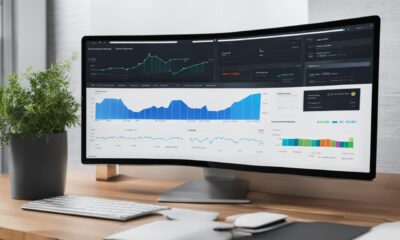Holistic SEO
SEO for Boutique Interior Design Studios: Designing a Visible Online Presence

Struggling to get your boutique interior design studio noticed online? Fear not, we’re here to support you!
In this article, we’ll reveal the secrets to designing a visible online presence through strategic SEO techniques.
From understanding the importance of SEO to staying up-to-date with the latest trends, our comprehensive guide will equip you with the knowledge and skills you need to master the art of online visibility.
Get ready to take your boutique interior design studio to new heights!

Key Takeaways
- Conducting thorough keyword research is essential for attracting the target audience and improving search engine visibility.
- Creating high-quality, keyword-rich content helps outrank competitors and engage the target audience.
- Utilizing social media platforms like Instagram and Pinterest can foster a sense of community and establish the brand as a trusted resource.
- Building a strong backlink profile through collaborations, guest blogging, and industry events can boost website authority and visibility.
Understanding the Importance of SEO
Understanding the importance of SEO is crucial for boutique interior design studios to establish a strong online presence. In today’s digital age, where consumers turn to search engines for everything they need, having a solid SEO strategy is essential for small businesses to compete and thrive.
Keyword research is the foundation of any successful SEO strategy. By identifying the right keywords that potential clients are searching for, boutique interior design studios can optimize their website content to enhance visibility and attract targeted traffic. This not only increases the chances of converting visitors into customers but also helps in outranking competitors in search engine results.
Implementing effective SEO strategies for small businesses involves various tactics. Creating high-quality, keyword-rich content that’s relevant and engaging is crucial. Regularly updating website content with fresh and informative articles, blog posts, and case studies not only keeps the audience engaged but also helps the website rank higher in search results. Additionally, optimizing on-page elements such as meta tags, headers, and URLs with relevant keywords can significantly improve search engine visibility.
Furthermore, building a strong backlink profile is vital for SEO success. By acquiring quality backlinks from reputable websites in the interior design industry, boutique studios can boost their website authority and improve search engine rankings.

Identifying Your Target Audience
To effectively identify our target audience, we need to consider two key factors: demographics and interests, and online behavior and preferences.
By understanding the demographics and interests of our potential customers, we can tailor our marketing efforts to better meet their needs and desires.
Additionally, analyzing their online behavior and preferences will help us determine the most effective channels and strategies to reach and engage with them.
Demographics and Interests
In this article, we’ll explore how to identify the demographics and interests of your target audience as a boutique interior design studio, in order to optimize your SEO and create a visible online presence.

Understanding the demographics and interests of your target audience is crucial for effectively targeting niche markets. By analyzing data such as age, gender, location, and income level, you can gain insights into who your potential customers are and what they’re interested in.
This information will help you tailor your website content and SEO strategies to attract and engage your target audience. Additionally, conducting market research and analyzing competitor websites can provide valuable insights into the preferences and behaviors of your target audience.
Online Behavior and Preferences
As boutique interior design studios, we continuously analyze the online behavior and preferences of our target audience in order to effectively optimize our SEO and create a visible online presence.
Understanding the online behavior and preferences of our audience is crucial for tailoring our marketing strategies and delivering relevant content. Here are some key insights we’ve gathered regarding online shopping and consumer behavior:

- Mobile-first approach: Our target audience prefers browsing and shopping on their mobile devices, so it’s important for us to ensure that our website is mobile-friendly and optimized for a seamless user experience.
- Visual content: Our audience is visually-oriented and appreciates high-quality images and videos showcasing our interior design work. We prioritize creating visually appealing content that inspires and engages our audience.
- Personalization: Our audience values personalized experiences and recommendations. We use data-driven insights to customize our website, emails, and advertisements to cater to their specific preferences.
- Social media influence: Our audience heavily relies on social media platforms for inspiration and recommendations. We actively engage with our audience on platforms such as Instagram and Pinterest to foster a sense of community and establish our brand as a trusted resource.
- User reviews and testimonials: Our audience heavily relies on user reviews and testimonials to make purchasing decisions. We prioritize collecting and displaying positive reviews to build trust and credibility with our audience.
Conducting Keyword Research
When it comes to conducting keyword research for our boutique interior design studio, we need to strategically target relevant keywords that will attract our target audience.
By optimizing our website content for SEO, we can ensure that our studio appears in search results when potential clients are looking for interior design services.
This research and optimization process is essential for building a visible online presence and driving organic traffic to our website.
Targeting Relevant Keywords
We conduct keyword research to target relevant keywords for our boutique interior design studio’s SEO strategy. This step is crucial in ensuring that our website ranks higher in search engine results and reaches our target audience effectively.

Here are five key points to consider when conducting keyword research:
- Understanding our target audience and their search behavior.
- Analyzing competitor websites and identifying their keyword strategies.
- Utilizing long tail keywords to target specific niches and attract quality traffic.
- Using keyword research tools to identify popular and relevant keywords.
- Continuously monitoring and updating our keyword strategy to stay ahead of the competition.
By targeting relevant keywords, we can optimize our website’s content for search engines and improve our online visibility.
In the next section, we’ll explore how to optimize our content for SEO, ensuring that our website is easily discoverable by our potential clients.
Optimizing Content for SEO
To optimize our website’s content for search engines and improve our online visibility, it’s essential to conduct thorough keyword research. Keyword research helps us identify the specific words and phrases that our target audience is using when searching for interior design services. By incorporating these keywords strategically into our website’s content, we can increase our chances of appearing in relevant search results.

When conducting keyword research, it’s important to consider the unique needs of boutique interior design studios. In addition to generic keywords such as ‘interior design’ and ‘home decor,’ we should also focus on keywords that highlight our specialization in boutique design. This could include keywords such as ‘unique interior design,’ ‘luxury home decor,’ or ‘personalized design services.’
Furthermore, incorporating visual elements into our SEO strategy can enhance our online presence. Optimizing images with relevant keywords and using descriptive alt text can improve our website’s visibility in image searches. Additionally, utilizing local directories can help us target potential clients in our specific geographical area. By listing our business in local directories and optimizing our information with location-specific keywords, we can attract local customers who are actively searching for interior design services in our area.
Optimizing Your Website’s On-Page Elements
In the process of optimizing a boutique interior design studio’s online presence, it’s crucial to focus on fine-tuning the on-page elements of the website. These elements play a vital role in improving website visibility and user experience, ultimately attracting and retaining potential clients.
Here are five key areas to pay attention to when optimizing your website’s on-page elements:

- Improving Website Navigation: Ensure that your website has a clear and intuitive navigation structure, allowing visitors to easily find the information they’re looking for. Use descriptive and concise menu labels to guide users through different sections of your website.
- Optimizing Image Alt Tags: Adding alt tags to your images not only helps improve accessibility for visually impaired users but also provides an opportunity to include relevant keywords. Use descriptive alt text that accurately represents the content of the image and aligns with your SEO strategy.
- Crafting Engaging Meta Titles and Descriptions: Meta titles and descriptions are displayed in search engine results and can significantly impact click-through rates. Craft compelling and concise titles and descriptions that accurately reflect the content of each page while enticing users to click.
- Utilizing Header Tags: Properly utilizing header tags (H1, H2, H3, etc.) helps search engines understand the structure and hierarchy of your content. Use header tags to organize your content, making it easier for both users and search engines to navigate.
- Enhancing Page Speed: Page speed is a crucial ranking factor and directly affects user experience. Optimize your website’s loading speed by compressing images, minifying CSS and JavaScript files, and leveraging browser caching.
Creating Engaging and Relevant Content
When it comes to creating engaging and relevant content for boutique interior design studios, quality should always be prioritized over quantity. By focusing on producing high-quality content that resonates with the target audience, we can ensure that our message is effectively delivered and received.
Consistency in creating and sharing content also plays a crucial role in building engagement and maintaining a visible online presence.
Quality Over Quantity
As boutique interior design studios, we prioritize quality over quantity by creating engaging and relevant content that resonates with our target audience. In order to achieve this, we employ effective strategies to measure the success of our content. Here are five key elements that contribute to our content’s effectiveness:
- Compelling storytelling: We craft narratives that captivate our audience, allowing them to connect emotionally with our brand.
- Visual appeal: Our content is visually stunning, leveraging high-quality images and videos to engage and inspire our audience.
- Expert insights: We provide expert advice and insights that showcase our industry knowledge and establish our credibility.
- User-generated content: We encourage our audience to share their experiences and showcase their own designs, fostering a sense of community and engagement.
- Consistency: We maintain a consistent tone and style across all our content, ensuring a cohesive brand identity.
By focusing on quality, we create content that not only attracts our target audience but also keeps them coming back for more.

Now, let’s delve into the importance of targeting the right audience.
Targeting the Right Audience
To effectively create engaging and relevant content, we consistently target the right audience using strategic SEO techniques.
Effective targeting is crucial in reaching the right audience for boutique interior design studios. By understanding our audience’s needs and preferences, we can tailor our content to resonate with them and provide value.
Niche marketing plays a significant role in reaching interior design enthusiasts who are actively seeking inspiration and professional advice. Through keyword research and analysis, we identify the specific topics and keywords that are relevant to our target audience. This allows us to create content that addresses their interests and solves their problems.

Consistency Breeds Engagement
We consistently target the right audience through strategic SEO techniques to create engaging and relevant content. By focusing on branding consistency and visual storytelling, we ensure that our content resonates with our audience and captures their attention.
Here are five key elements that contribute to the engagement of our content:
- Compelling visuals: We use high-quality images and videos to visually communicate our brand story and captivate our audience.
- Authentic storytelling: We share our unique experiences, client success stories, and design journeys to create a personal connection with our audience.
- Consistent messaging: We maintain a consistent tone and style across all our content, reinforcing our brand identity and building trust with our audience.
- Interactive elements: We incorporate interactive elements like quizzes, polls, and surveys to encourage audience participation and make our content more engaging.
- Timely and relevant topics: We stay updated with industry trends and address topics that are relevant to our audience’s interests and needs.
By consistently implementing these strategies, we create content that not only engages our audience but also strengthens our brand presence.
This paves the way for the subsequent section on building high-quality backlinks, which further enhances our online visibility and authority.

Building High-Quality Backlinks
Building a network of authoritative links is essential for boosting the visibility and credibility of boutique interior design studios in search engine rankings. As an interior design studio, it is crucial to implement effective link building strategies and build relationships with industry influencers to establish a strong online presence.
To create high-quality backlinks, it is important to focus on acquiring links from reputable and relevant websites. This can be achieved through guest blogging, where you contribute valuable content to industry-related blogs and include a link back to your website. Additionally, collaborating with influencers in the interior design industry can help you gain exposure and earn valuable backlinks from their websites.
Here is a table that outlines some effective strategies for building high-quality backlinks:
| Link Building Strategies | Building Relationships with Industry Influencers |
|---|---|
| Guest blogging | Collaborating on content or projects |
| Creating shareable content | Engaging with influencers on social media |
| Participating in industry events and conferences | Offering to provide expert insights or tips for influencers’ articles |
By implementing these strategies, boutique interior design studios can increase their online visibility and establish themselves as authorities in the industry.

In the next section, we will explore the importance of utilizing local SEO strategies to further enhance the online presence of boutique interior design studios.
Utilizing Local SEO Strategies
Implementing local SEO strategies is essential for boutique interior design studios to enhance their online presence within their target geographic area. By focusing on local search optimization, these studios can effectively attract potential clients in their vicinity.
Here are five key strategies to consider:
- Local Citations: Ensuring consistent and accurate information across online directories and platforms increases credibility and visibility.
- Geo Targeted Keywords: Incorporating location-specific keywords in website content helps search engines understand the studio’s relevance to local searches.
- Google My Business: Optimizing the studio’s Google My Business listing with accurate contact information, images, and reviews improves local search rankings.
- Local Content Creation: Developing blog posts or articles that highlight local projects, collaborations, or design trends can attract local audiences and establish the studio as an authority in the area.
- Online Reviews: Encouraging satisfied clients to leave positive reviews on platforms like Google and Yelp can boost the studio’s reputation and attract more local customers.
By implementing these local SEO strategies, boutique interior design studios can increase their visibility and attract clients within their target geographic area.

Now, let’s explore the next section on optimizing for mobile devices to ensure a seamless user experience across all devices.
Optimizing for Mobile Devices
Continuing to prioritize local SEO strategies, optimizing for mobile devices becomes crucial for boutique interior design studios to ensure a seamless user experience across all devices. With the rise of mobile usage and the increasing number of people accessing the internet through their smartphones and tablets, it’s imperative for interior design studios to adapt their websites to fit the needs of mobile users.
Mobile optimization involves creating a responsive design that adjusts to different screen sizes and resolutions. This ensures that the website displays properly on all devices, providing a user-friendly experience and preventing potential frustrations such as distorted images or difficult navigation. By implementing mobile optimization techniques, boutique interior design studios can enhance their online presence and reach a wider audience.
In addition to improving user experience, mobile optimization also has a significant impact on SEO. Search engines like Google prioritize mobile-friendly websites in their search results, making it essential for interior design studios to optimize their sites for mobile devices. By doing so, they increase their chances of ranking higher in search engine results pages, driving more organic traffic to their websites.

As we move forward, it’s important to also consider enhancing the user experience and site speed. By focusing on these aspects, boutique interior design studios can further improve their online presence and ensure that visitors have a positive experience when browsing their websites.
Enhancing User Experience and Site Speed
To improve the overall user experience and increase site speed, we prioritize optimizing website design and functionality. By focusing on improving website navigation and optimizing images for faster loading, we aim to create a seamless and efficient browsing experience for our users.
Here are five key strategies we implement to enhance user experience and site speed:
- Streamlining navigation: We ensure that our website’s navigation is intuitive and user-friendly, making it easy for visitors to find the information they need quickly and effortlessly.
- Optimizing images: We compress and resize images to reduce file sizes without compromising quality. This not only helps in faster loading times but also improves the overall performance of our website.
- Implementing caching techniques: By utilizing caching techniques, we reduce the need for repeated server requests, resulting in faster load times for returning visitors.
- Minimizing HTTP requests: We minimize the number of HTTP requests by combining CSS and JavaScript files, reducing the overall load time of our website.
- Utilizing responsive design: Our website is designed to be fully responsive across different devices and screen sizes, ensuring a consistent and enjoyable user experience for all visitors.
Leveraging Social Media for SEO
To leverage social media for SEO, we focus on engaging with our audience through strategic content creation and consistent interaction. Social media platforms provide an excellent opportunity to build brand awareness, increase website traffic, and improve search engine rankings. By implementing effective social media advertising strategies, we can not only reach a wider audience but also enhance our online visibility.

One of the key ways we leverage social media for branding is by creating compelling and shareable content. This includes blog posts, infographics, videos, and images that resonate with our target audience. We ensure that our content is optimized for search engines, incorporating relevant keywords and tags to improve its visibility on social media platforms.
Consistent interaction with our audience is also crucial. We actively respond to comments, messages, and mentions, fostering a sense of community and building trust. This engagement not only increases brand loyalty but also encourages social sharing, which can significantly impact our SEO efforts.
To illustrate the importance of leveraging social media for SEO, we have created the following table:
| Benefits of Leveraging Social Media for SEO |
|---|
| Increased brand awareness |
| Higher website traffic |
| Improved search engine rankings |
| Enhanced online visibility |
Monitoring and Analyzing Performance Metrics
We regularly track and analyze key performance metrics to assess the effectiveness of our SEO strategies. Measuring success and tracking performance are essential for optimizing our online presence and ensuring that we’re achieving our goals.

Here are five important metrics that we monitor and analyze:
- Organic search traffic: We track the number of visitors who find our website through organic search results. This metric helps us understand the impact of our SEO efforts on driving traffic to our site.
- Conversion rate: We measure the percentage of visitors who take a desired action, such as making a purchase or filling out a contact form. Monitoring this metric allows us to evaluate the effectiveness of our website in converting visitors into customers.
- Keyword rankings: We keep a close eye on the rankings of our target keywords in search engine results pages. By tracking these rankings, we can assess whether our SEO strategies are improving our visibility and positioning.
- Bounce rate: This metric indicates the percentage of visitors who leave our website after viewing only one page. A high bounce rate may suggest that our content or user experience needs improvement.
- Backlink profile: We analyze the quality and quantity of backlinks pointing to our website. Monitoring our backlink profile helps us identify opportunities for link building and measure the impact of our efforts in improving our website’s authority.
By regularly monitoring and analyzing these performance metrics, we can make data-driven decisions to optimize our SEO strategies and improve our online visibility.
In the next section, we’ll discuss implementing SEO best practices for e-commerce websites.
Implementing SEO Best Practices for E-Commerce Websites
Implementing SEO best practices for e-commerce websites involves optimizing various aspects of the site to improve visibility and search engine rankings. In the competitive world of online retail, it’s essential for businesses to develop effective SEO strategies for niche e-commerce markets. These strategies focus on targeting specific keywords and optimizing product descriptions, titles, and URLs to attract relevant traffic and improve conversion rates.

One crucial aspect of implementing SEO for e-commerce websites is striking the right balance between SEO and branding. While it’s important to optimize the site for search engines, it’s equally crucial to maintain a consistent and appealing brand identity. This can be achieved by incorporating keywords naturally into the website content and design, without compromising the overall aesthetic and user experience.
Another essential aspect of SEO for e-commerce websites is optimizing the site structure and navigation. Ensuring that the website is user-friendly and easily navigable not only improves the user experience but also helps search engines crawl and index the site more effectively.
Additionally, implementing SEO best practices for e-commerce websites involves optimizing the site for mobile devices. With the increasing use of smartphones for online shopping, having a mobile-friendly website is vital for attracting and retaining customers.
Staying Up-To-Date With SEO Trends and Algorithm Changes
In order to stay current with SEO trends and algorithm changes, it’s essential for us as boutique interior design studios to consistently adapt our strategies and techniques. As the digital landscape evolves, staying ahead of the game becomes crucial in maintaining a visible online presence.

Here are five key points to consider when it comes to staying up-to-date with SEO trends and algorithm changes:
- Regularly monitor industry news and updates: Keeping a close eye on the latest developments in SEO will allow us to identify any algorithm changes or trends that may impact our strategies.
- Analyze website analytics: By regularly analyzing our website analytics, we can gain insights into user behavior, keyword performance, and overall site visibility. This data can help us identify areas for improvement and adapt our strategies accordingly.
- Stay informed about mobile optimization: With the increasing use of mobile devices, optimizing our website for mobile users is crucial. Staying updated on mobile SEO best practices will ensure that our site remains accessible and user-friendly across all devices.
- Embrace content marketing strategies: Content remains a key driver of SEO success. By continually adapting our content marketing strategies, such as incorporating relevant keywords and creating high-quality, engaging content, we can maintain our visibility in search engine rankings.
- Leverage social media platforms: Social media can play a significant role in boosting our online presence. By staying current with social media trends and algorithms, we can effectively engage with our target audience and drive traffic to our website.
Frequently Asked Questions
How Can I Optimize My Website’s On-Page Elements for Better Seo?
To optimize our website’s on-page elements for better SEO, we implement strategic SEO strategies for boutique studios. By analyzing and improving our website’s structure, meta tags, and keyword usage, we can enhance our online visibility and attract more organic traffic.
What Are Some Effective Local SEO Strategies That I Can Use for My Boutique Interior Design Studio?
To boost our boutique interior design studio’s visibility online, we can maximize local business directories for strong local SEO. Content marketing, through engaging blog posts and articles, will attract local customers and improve our SEO.
How Can I Leverage Social Media to Improve My Website’s Seo?
To improve website traffic through social media engagement, we can leverage various platforms to drive targeted traffic, increase brand exposure, and encourage user interaction. This will ultimately boost our SEO efforts and enhance our online visibility.

What Are Some Key Performance Metrics That I Should Monitor and Analyze to Gauge the Success of My SEO Efforts?
To gauge the success of our SEO efforts, we monitor and analyze key performance metrics such as SEO tracking and SEO analysis. These metrics provide valuable insights into the effectiveness of our strategies and help us make data-driven decisions.
How Can I Stay Up-To-Date With the Latest SEO Trends and Algorithm Changes?
To stay up-to-date with SEO trends and algorithm changes, we need to constantly monitor industry news and resources. Adapting best practices for SEO algorithm updates is crucial for staying ahead of the competition in the interior design industry.
Conclusion
In conclusion, mastering SEO for boutique interior design studios is like having the key to unlock a hidden treasure trove of online visibility. By understanding your target audience, conducting keyword research, and optimizing your website, you can design a visible online presence that attracts and captivates your ideal clients.
Additionally, creating engaging content and leveraging social media are crucial components of an effective SEO strategy. Engaging content that is relevant to your audience’s interests and needs will not only help improve your search engine rankings but also keep users on your website longer, increasing the likelihood of conversion.

Furthermore, staying up-to-date with SEO trends is essential for maintaining your online visibility. SEO is a constantly evolving field, with search engine algorithms frequently changing. By staying informed about the latest trends and best practices, you can adapt your strategy accordingly and stay ahead of the competition.
With SEO as your compass, your boutique interior design studio can navigate the digital landscape with confidence and success. By implementing these strategies and consistently monitoring and optimizing your SEO efforts, you can establish a strong online presence that drives traffic, increases conversions, and ultimately helps your business thrive.
Holistic SEO
Guide to Holistic SEO for Optimal Website Performance

Welcome to our detailed guide on Complete SEO for maximizing website performance.
Are you ready to master the art of driving organic traffic and improving your online presence?
In this article, we will delve into the importance of holistic SEO and provide you with practical on-page optimization techniques, off-page optimization strategies, and technical SEO best practices.
We will also explore how to measure and analyze your website’s performance to ensure continuous growth.
Get ready to take your website to the next level!
Key Takeaways
- User experience is crucial for website performance, leading to longer stay and higher conversion rates.
- Integrating social media enhances holistic SEO strategy, increasing audience engagement, brand awareness, and traffic.
- On-page optimization techniques, such as keyword research and content optimization, improve website visibility and ranking on search engine result pages (SERPs).
- Off-page optimization strategies, including guest blogging and backlink building, enhance website visibility and organic traffic.
Importance of Holistic SEO
In our experience, holistic SEO is vital for achieving optimal website performance. The role of user experience in holistic SEO can’t be overstated. When users have a positive experience on your website, they’re more likely to stay longer, explore further, and ultimately convert into customers. This is why it’s important to focus on elements such as page load speed, mobile responsiveness, and intuitive navigation.
Additionally, integrating social media into your holistic SEO strategy can have numerous benefits. Social media platforms provide an opportunity to engage with your audience, build brand awareness, and drive traffic to your website. By sharing valuable content and encouraging social sharing, you can increase your online visibility and attract more organic traffic.
As we transition into the subsequent section about on-page optimization techniques, it’s important to remember that a holistic SEO approach considers all aspects of your website to ensure maximum performance.
On-Page Optimization Techniques
To optimize your website’s performance, we’ll now delve into the subtopic of on-page optimization techniques. On-page optimization plays a crucial role in improving your website’s visibility and ranking on search engine result pages (SERPs).
Two key components of on-page optimization are keyword research and content optimization.
Keyword research involves identifying the most relevant and high-performing keywords that align with your website’s content and target audience. By conducting comprehensive keyword research, you can optimize your website’s content to increase its chances of ranking higher in search engine results.
Content optimization focuses on optimizing the various elements on your web pages, such as headings, meta tags, URLs, and image alt text, to make them more search engine friendly. This includes incorporating target keywords strategically throughout your content and ensuring it’s relevant, engaging, and well-structured.
Off-Page Optimization Strategies
We will now explore the effectiveness of incorporating off-page optimization strategies into our holistic SEO approach. Off-page optimization refers to the techniques used outside of our website to improve search engine rankings.
Two key strategies for off-page optimization are guest blogging and backlink building.
Guest blogging involves writing and publishing content on other websites within our industry. This allows us to showcase our expertise, reach a wider audience, and build valuable backlinks to our website.
Backlink building is the process of acquiring links from other websites that point back to our own. These links act as votes of confidence and authority, signaling to search engines that our website is trustworthy and relevant.
By implementing these off-page optimization strategies, we can enhance our website’s visibility, increase organic traffic, and improve search engine rankings.
It’s essential to have a well-rounded SEO approach that includes both on-page and off-page optimization techniques to achieve optimal website performance.
Technical SEO Best Practices
Continuing our exploration of effective off-page optimization strategies, let’s now delve into the realm of technical SEO best practices.
When it comes to optimizing your website for search engines, conducting an SEO audit is crucial. An SEO audit checklist can help ensure that all technical aspects of your website are in order. It involves assessing factors such as website speed, mobile-friendliness, URL structure, and metadata optimization.

Another important aspect of technical SEO is keyword research. By utilizing keyword research techniques, you can identify the most relevant and high-performing keywords to target on your website. This will help improve your website’s visibility and drive organic traffic.
Technical SEO plays a vital role in optimizing your website’s performance and ensuring that it’s easily discoverable by search engines.
Measuring and Analyzing Website Performance
As we delve into the realm of measuring and analyzing website performance, let’s explore the importance of utilizing data-driven insights to optimize our website for optimal results.
Website analytics play a crucial role in understanding how our website is performing and identifying areas for improvement. By analyzing metrics such as traffic sources, page views, bounce rate, and conversion rate, we can gain valuable insights into user behavior and preferences.
These insights allow us to make informed decisions about our website’s design, content, and marketing strategies. Monitoring conversion rate is especially important as it directly impacts our website’s effectiveness in achieving its goals, whether it’s generating leads, making sales, or increasing engagement.
Frequently Asked Questions
How Long Does It Take to See Results From Holistic SEO Efforts?
On average, it takes time to see results from holistic SEO efforts. Success is measured by tracking website performance over time. This guide provides insights on optimizing SEO for optimal website performance.
Can I Implement Holistic SEO Strategies on My Own, or Do I Need to Hire an SEO Agency?
Implementing holistic SEO strategies on your own or hiring an agency? Weigh the pros and cons. DIY can save money but requires time and expertise. Hiring an agency provides expertise but can be costly. Measure success through improved website performance.
What Are Some Common Mistakes to Avoid When Implementing Holistic Seo?
When implementing holistic SEO, it’s important to avoid common mistakes to ensure optimal website performance. By understanding the benefits of holistic SEO in e-commerce websites, we can achieve mastery in our SEO strategies.
Are There Any Specific Industries or Types of Websites That Can Benefit the Most From Holistic Seo?
In our experience, specific industries or types of websites that can benefit the most from holistic SEO include e-commerce, healthcare, and local businesses. Key factors to consider for successful implementation are keyword research, content optimization, and technical SEO.
How Does Holistic SEO Differ From Traditional SEO Practices?
Holistic SEO differs from traditional SEO practices in its focus on long-term success and a comprehensive approach. It emphasizes the benefits of optimizing all aspects of a website, including content, user experience, and technical elements, for optimal performance and search engine visibility.
What Are the Key Strategies to Achieve Full-Scale Website Optimization with Holistic SEO?
Implementing holistic seo website optimization requires a combination of key strategies. Firstly, conducting comprehensive keyword research to understand user intent is crucial. Next, optimizing on-page elements such as meta tags, headers, and content structure ensure search engines understand your website fully. Additionally, creating unique and valuable content, optimizing site speed, and prioritizing mobile responsiveness contribute to a holistic SEO approach. Building quality backlinks and monitoring analytics regularly further refine optimization efforts.
Conclusion
In conclusion, implementing holistic SEO is essential for achieving optimal website performance. By focusing on both on-page and off-page optimization techniques, as well as technical SEO best practices, you can boost your website’s visibility and organic traffic.
It’s like tending to a well-maintained garden, where each aspect contributes to the overall beauty and health of the plants. By measuring and analyzing website performance, you can continuously improve and refine your SEO strategy, ensuring long-term success.

Holistic SEO
Mastering Holistic SEO for Full-Scale Website Optimization

Are you prepared to master comprehensive SEO in order to improve your entire website? We are here to help you.
In this article, we’ll guide you through the fundamentals of holistic SEO, from keyword research and analysis to on-page and off-page optimization techniques.
We’ll also show you how to measure and analyze SEO performance to ensure maximum results.
Get ready to take your website to the next level and achieve true mastery in the world of SEO.
Let’s dive in.
Key Takeaways
- Content marketing strategies attract and engage the target audience.
- Thorough keyword research uncovers valuable keywords.
- User experience optimization enhances engagement and conversions.
- Mastering keyword research maximizes online visibility.
The Fundamentals of Holistic SEO
When implementing holistic SEO strategies, we prioritize understanding the fundamentals of optimizing a website for full-scale performance. One of the key aspects of holistic SEO is content marketing strategies. By creating valuable and relevant content, we can attract and engage our target audience while also improving our website’s visibility in search engine results. This involves conducting thorough keyword research, crafting compelling headlines, and optimizing our content with relevant keywords and meta tags.
Another fundamental aspect of holistic SEO is user experience optimization. It’s crucial to ensure that our website provides a seamless and enjoyable experience for users. This includes optimizing website speed, improving navigation and site structure, and making our content easily accessible and readable. By prioritizing user experience, we can enhance engagement, increase conversions, and improve overall website performance.
Keyword Research and Analysis
To continue our discussion on holistic SEO, let’s delve into the importance of keyword research and analysis for optimizing a website’s performance.
Keyword research is a critical step in understanding the search behavior of your target audience and identifying the most relevant and valuable keywords to target.
Here are four key reasons why keyword research and analysis are crucial for website optimization:
- Identify high-value keywords: By conducting competitive analysis and researching industry trends, you can uncover valuable keywords that have high search volume and low competition.
- Discover long tail keywords: Long tail keywords are more specific and less competitive, allowing you to target niche audiences and drive targeted traffic to your website.
- Optimize content: Keyword research helps you optimize your website content by strategically incorporating relevant keywords into your titles, headings, meta tags, and body content.
- Stay ahead of the competition: By continuously analyzing keywords and monitoring your competitors’ keyword strategies, you can stay ahead in the search rankings and attract more organic traffic.
Mastering keyword research and analysis is essential for achieving full-scale website optimization and maximizing your online visibility.
On-Page Optimization Techniques
Now let’s explore On-Page Optimization Techniques, which play a crucial role in enhancing a website’s performance and visibility.
On-page optimization focuses on optimizing individual web pages to improve their search engine rankings and attract more organic traffic. One key aspect of on-page optimization is content optimization, which involves creating high-quality, relevant, and keyword-rich content that resonates with your target audience.
This includes using appropriate headings, subheadings, and incorporating relevant keywords naturally throughout the content. Another important on-page optimization technique is optimizing meta tags, such as title tags and meta descriptions.
These tags provide a concise summary of the page’s content and help search engines understand what the page is about. By optimizing these elements, you can increase the chances of your website ranking higher in search engine results.
In the next section, we’ll delve into off-page optimization strategies to further enhance your website’s visibility and authority.
Off-Page Optimization Strategies
Continuing from the previous subtopic, we can explore off-page optimization strategies to further enhance our website’s visibility and authority. Off-page optimization focuses on improving our website’s reputation and credibility through external factors. Here are four key strategies to consider:
- Link Building: Building high-quality backlinks from reputable websites can significantly improve our website’s search engine rankings. It’s important to focus on acquiring natural and relevant links that demonstrate our authority and expertise in our industry.
- Social Media Presence: Having an active and engaging presence on social media platforms can help increase brand awareness, drive traffic to our website, and improve search engine visibility. It’s crucial to create valuable content and engage with our audience to build a strong online community.
- Guest Blogging: Collaborating with influential bloggers or industry experts to publish guest posts on their websites can help us reach a wider audience and gain valuable backlinks. It’s essential to choose relevant and reputable websites that align with our niche.
- Online Reputation Management: Monitoring and managing our online reputation is crucial for building trust and credibility. Responding to customer reviews, addressing negative feedback, and actively managing our brand image can positively impact our website’s visibility and authority.
By implementing these off-page optimization strategies, we can enhance our website’s visibility, credibility, and ultimately improve our overall SEO performance.
In the next section, we’ll explore the importance of measuring and analyzing SEO performance to ensure continuous improvement.
Measuring and Analyzing SEO Performance
Measuring and analyzing SEO performance is essential for evaluating the effectiveness of our optimization efforts and identifying areas for improvement. Without proper tracking and analysis of SEO data, we would be blindly implementing strategies without knowing whether they are yielding the desired results. By monitoring key metrics such as organic traffic, keyword rankings, and conversion rates, we can gain valuable insights into the performance of our website and make informed decisions to drive better results.
In addition to tracking our own SEO performance, competitor analysis is also crucial for staying ahead in the game. By analyzing the SEO strategies of our competitors, we can identify opportunities and uncover areas where we can outperform them. This involves evaluating their keyword rankings, backlink profiles, and content strategies to gain a competitive edge.
To help visualize the importance of measuring and analyzing SEO performance, here is a table showcasing some key metrics and their significance:
| Metric | Significance |
|---|---|
| Organic Traffic | Indicates the amount of traffic generated through search engines, reflecting the reach of our website. |
| Keyword Rankings | Shows how well our website ranks for targeted keywords, indicating visibility and competitiveness. |
| Conversion Rates | Measures the percentage of visitors who take desired actions, providing insights into website effectiveness. |
Frequently Asked Questions
What Is the Impact of Holistic SEO on Website Loading Speed?
The impact of holistic SEO on website loading speed is significant. By optimizing various elements such as code, images, and server response time, holistic SEO improves website performance, resulting in faster loading times and better rankings.
How Can I Optimize My Website for Voice Search Using Holistic SEO Techniques?
To optimize our website for voice search, we employ holistic SEO techniques. By focusing on keyword research, mobile optimization, and natural language content, we ensure our site is primed for voice search queries.
Are There Any Specific SEO Techniques for Optimizing Mobile Websites?
Yes, there are specific SEO techniques for optimizing mobile websites. A mobile first approach and responsive design are crucial. By prioritizing mobile users and ensuring a seamless experience, you can improve search rankings and overall website performance.
Can You Provide Examples of Successful Holistic SEO Strategies Implemented by Major Brands?
Successful holistic SEO strategies implemented by major brands showcase the importance of website loading speed. These brands prioritize optimization techniques such as mobile responsiveness, quality content creation, backlink building, and user experience enhancement.
How Does Holistic SEO Contribute to Improving User Experience on a Website?
Improving website usability and enhancing content relevance are key aspects of holistic SEO. By optimizing user experience, we ensure that visitors find what they need quickly and easily, increasing engagement and conversions.
What is the Difference Between Comprehensive SEO and Holistic SEO?
When it comes to digital marketing strategies, understanding the difference between comprehensive SEO and holistic SEO is crucial. While comprehensive SEO focuses on optimizing specific elements of a website to improve its search engine rankings, holistic SEO takes a broader approach and encompasses all aspects of an online presence, including content marketing. By integrating comprehensive seo in content marketing efforts, businesses can ensure their strategies align with search engine algorithms and reach a wider audience.
Conclusion
In conclusion, mastering holistic SEO is the ultimate key to unlocking full-scale website optimization. By seamlessly integrating keyword research, on-page optimization techniques, and off-page optimization strategies, we can achieve remarkable results in our SEO performance.

With a keen eye for analyzing and measuring our efforts, we can strategically optimize our website to attract maximum organic traffic and dominate the digital landscape.
Don’t settle for mediocre SEO, go all-in with holistic optimization and watch your website soar to new heights.
Holistic SEO
Impact of Social Media on Holistic SEO Practices

In the digital world, social media plays a crucial role in comprehensive SEO strategies. It helps enhance visibility, build brand awareness, and boost user engagement.
With its power to amplify content and strengthen online reputation, social media acts as a beacon, guiding our website towards higher search engine rankings and organic reach.
As we embark on this journey, let us delve into the symbiotic relationship between social media and holistic SEO, unveiling the impact it holds for our mastery in the digital realm.
Key Takeaways
- Social media platforms can be effectively utilized to increase visibility and brand awareness.
- Collaborating with influencers can boost brand visibility and reach a wider audience.
- Analyzing social media analytics helps to understand user behavior and optimize website traffic.
- Leveraging social media strategies can enhance SEO practices and improve search engine rankings.
Increased Visibility and Brand Awareness
To increase visibility and brand awareness, it’s essential that we utilize social media platforms effectively.
Social media advertising and influencer marketing play a crucial role in achieving these goals. By running targeted ad campaigns on platforms like Facebook, Instagram, and Twitter, we can reach a wider audience and increase our brand’s exposure. These platforms offer advanced targeting options, allowing us to reach specific demographics based on factors like age, location, and interests.
Additionally, collaborating with influencers who’ve a large and engaged following can significantly boost our brand’s visibility. Influencer marketing allows us to tap into the trust and influence that these individuals have built with their audience. By aligning our brand with influencers that resonate with our target market, we can increase awareness and credibility, leading to a higher likelihood of conversions and customer loyalty.
Improved Website Traffic and User Engagement
As we continue exploring the impact of social media on holistic SEO practices, it’s important to note how it contributes to improved website traffic and user engagement.
Social media analytics play a crucial role in understanding user behavior and preferences, allowing us to optimize our website to drive more targeted traffic. By analyzing data from social media platforms, we can identify the type of content that resonates with our target audience and tailor our SEO strategies accordingly.
Furthermore, influencer partnerships can significantly boost website traffic and user engagement. Collaborating with influencers who have a large following and influence in our industry can help us reach a wider audience and increase brand visibility. These partnerships can lead to higher engagement rates, increased website visits, and ultimately, improved search engine rankings.
With these tactics in place, we can ensure that our website receives higher traffic and engages users effectively. This sets the stage for the subsequent section on enhanced content distribution and amplification.
Enhanced Content Distribution and Amplification
We optimize our content distribution and amplify our reach through social media channels. By strategically targeting our outreach efforts and forming influencer partnerships, we ensure that our content reaches the right audience and receives maximum exposure. Through targeted outreach, we identify and engage with individuals and communities who are most likely to be interested in our content. This helps us connect with our target audience on a deeper level, fostering stronger relationships and driving higher engagement. Additionally, by partnering with influencers who have a strong following and influence in our niche, we are able to leverage their reach and credibility to amplify the distribution of our content. This results in increased visibility, brand awareness, and ultimately, higher conversions.
| Targeted Outreach | Influencer Partnerships |
|---|---|
| Identify relevant individuals and communities | Collaborate with influencers in our niche |
| Engage with target audience on a deeper level | Leverage their reach and credibility |
| Foster stronger relationships | Amplify distribution of content |
| Drive higher engagement | Increase visibility and brand awareness |
Strengthened Online Reputation and Credibility
Our strong online reputation and credibility are key assets in building trust with our audience. In today’s digital age, where information is readily available and opinions can spread quickly, it’s essential to manage our online credibility effectively. Reputation management plays a vital role in establishing and maintaining a positive image for our brand.
Here are four reasons why a strengthened online reputation is crucial:
- Increased trust: When our audience sees positive reviews, testimonials, and recommendations from others, it enhances their trust in our brand and establishes us as a credible source.
- Improved brand perception: A strong online reputation helps shape how our audience perceives our brand. Positive feedback and interactions can contribute to a positive brand image.
- Enhanced customer loyalty: When customers trust our brand, they’re more likely to stay loyal and recommend our products or services to others.
- Competitive advantage: In a crowded online marketplace, a strong online reputation sets us apart from our competitors. It gives us an edge and attracts potential customers who value credibility and reliability.
Boosted Search Engine Rankings and Organic Reach
Through the integration of social media, we can achieve higher search engine rankings and expand our organic reach. Social media advertising and influencer partnerships play a crucial role in boosting our website’s visibility and driving organic traffic.
Social media advertising allows us to target specific demographics and promote our content to a wider audience. By leveraging the advanced targeting options provided by social media platforms, we can reach users who are more likely to engage with our website and increase our chances of ranking higher in search engine results.
In addition, influencer partnerships enable us to tap into the existing follower base of popular influencers. By collaborating with influencers who align with our brand values, we can leverage their influence to reach a larger audience and drive more organic traffic to our website. This increased visibility can lead to higher search engine rankings, as search engines often prioritize websites with higher organic traffic.
Frequently Asked Questions
How Can Social Media Impact the Overall Visibility and Brand Awareness of a Business?
Social media’s impact on brand perception and leveraging social media influencers for business growth are key factors in increasing overall visibility and brand awareness. These strategies are essential for holistic SEO practices.
What Strategies Can Be Implemented to Improve Website Traffic and User Engagement Through Social Media Platforms?
To improve website traffic and user engagement through social media platforms, we can implement strategies such as website optimization and social media advertising. These tactics can increase visibility and attract more visitors to our site.
How Does Social Media Contribute to Enhanced Content Distribution and Amplification?
Social media reach is crucial for content amplification. It helps in enhancing content distribution by reaching a wider audience, increasing visibility, and driving traffic to websites. Social media’s impact on content amplification cannot be underestimated.
What Are Some Effective Ways to Strengthen Online Reputation and Credibility Using Social Media?
To build trust and establish authority using social media, we focus on strategies like consistently sharing valuable content, engaging with our audience, and showcasing positive customer testimonials. These tactics enhance our online reputation and credibility.
Can Social Media Efforts Alone Boost Search Engine Rankings and Organic Reach, or Should They Be Combined With Other SEO Practices?
Social media efforts alone may not boost search engine rankings and organic reach. Combining them with other SEO practices is crucial. Integration between social media and SEO is necessary for effective results. Social media analytics and measurement play a significant role in achieving mastery.
What Are the Key Ways That Social Media Influences Holistic SEO?
Social media’s impact on holistic seo is substantial. Firstly, it enhances website visibility by allowing businesses to share content and engage with their audience. Secondly, social signals from platforms like Facebook and Twitter contribute to search engines’ ranking algorithms. Lastly, social media drives organic traffic, which increases the likelihood of gaining quality backlinks. Overall, integrating social media into SEO strategy is essential for online success.
Conclusion
In conclusion, the impact of social media on holistic SEO practices is undeniable.
By leveraging social media platforms, businesses can increase their visibility and brand awareness, drive more website traffic and user engagement, distribute and amplify their content, and strengthen their online reputation and credibility.
This ultimately leads to boosted search engine rankings and organic reach.
Social media is like a powerful engine, propelling businesses towards their SEO goals with speed and efficiency.
-

 Expert Content Authority3 months ago
Expert Content Authority3 months agoThe Pillar of SEO: Why Content Consistency Matters Most
-

 Learning Center3 months ago
Learning Center3 months agoUncover How To Use ChatGPT to Write Effective Ad Copy
-

 Learning Center3 months ago
Learning Center3 months agoAI in 2024: 10 Things We are NOT Looking Forward To
-

 Holistic SEO5 hours ago
Holistic SEO5 hours agoHolistic Local SEO Tactics for Small Businesses
-

 Learning Center3 months ago
Learning Center3 months agoOptimize Your Digital Experience with Akamai CDN
-

 Learning Center3 months ago
Learning Center3 months agoUnbiased RankerX Review: A Deep Dive into Its SEO Capabilities
-

 Holistic SEO3 months ago
Holistic SEO3 months agoMoney Robot Review [2024]
-

 Learning Center3 months ago
Learning Center3 months agoExperience How GPT-4 Turbo Beats Claude 2: A Review

















